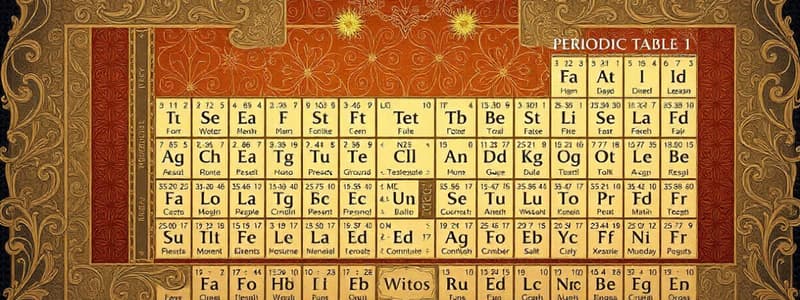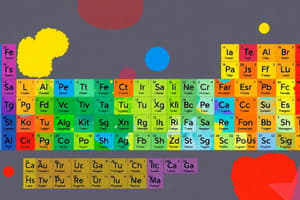Podcast
Questions and Answers
Which statement accurately describes the relationship between the atomic number and the number of electrons in a neutral atom?
Which statement accurately describes the relationship between the atomic number and the number of electrons in a neutral atom?
- The atomic number is always equal to the number of electrons. (correct)
- The atomic number is always less than the number of electrons.
- The atomic number is always half the number of electrons.
- The atomic number is always greater than the number of electrons.
Elements within the same group on the periodic table share which of the following characteristics?
Elements within the same group on the periodic table share which of the following characteristics?
- They have the same number of neutrons.
- They have the same atomic mass.
- They have the same number of electron shells.
- They have the same number of valence electrons. (correct)
Which of the following best describes the difference between metals and nonmetals on the periodic table?
Which of the following best describes the difference between metals and nonmetals on the periodic table?
- Metals are typically more reactive than nonmetals.
- Metals are typically more malleable and ductile than nonmetals. (correct)
- Metals are typically more abundant in nature than nonmetals.
- Metals are typically gases at room temperature, while nonmetals are typically solids.
What type of bond is formed when two nonmetals share electrons?
What type of bond is formed when two nonmetals share electrons?
What is the primary factor determining the chemical properties of an element?
What is the primary factor determining the chemical properties of an element?
Which of the following is NOT a characteristic of a molecule?
Which of the following is NOT a characteristic of a molecule?
What is the main difference between an atom and a molecule?
What is the main difference between an atom and a molecule?
Which of the following statements best describes the role of electrons in chemical bonding?
Which of the following statements best describes the role of electrons in chemical bonding?
Flashcards
Periodic Table
Periodic Table
A tabular arrangement of chemical elements based on atomic number and properties.
Atomic Number
Atomic Number
The number of protons in an atom's nucleus, defining the element.
Valence Electrons
Valence Electrons
Electrons in the outermost shell, influencing chemical properties.
Metals
Metals
Signup and view all the flashcards
Molecules
Molecules
Signup and view all the flashcards
Covalent Bonds
Covalent Bonds
Signup and view all the flashcards
Electron Configuration
Electron Configuration
Signup and view all the flashcards
Chemical Formula
Chemical Formula
Signup and view all the flashcards
Study Notes
The Periodic Table
- The periodic table is a tabular arrangement of all known chemical elements, organized by their atomic number, electron configuration, and recurring chemical properties.
- Elements are arranged in rows (periods) and columns (groups or families).
- Elements in the same group have similar chemical properties because they have the same number of valence electrons.
- Elements are categorized as metals, nonmetals, and metalloids based on their properties. Metals are typically shiny, good conductors of heat and electricity, while nonmetals are generally poor conductors and often have varying appearances. Metalloids exhibit properties of both.
- Atomic number represents the number of protons in an atom's nucleus.
- Atomic mass is the combined mass of protons and neutrons in an atom.
- Elements within the same period share a similar number of electron shells.
- The periodic table helps predict the chemical behavior of elements and their combinations.
Atoms
- Atoms are the fundamental building blocks of matter.
- Atoms are composed of three main subatomic particles: protons, neutrons, and electrons.
- Protons have a positive charge, and they are located in the atom's nucleus.
- Neutrons have no charge (neutral) and are also located in the nucleus.
- Electrons have a negative charge and orbit the nucleus in electron orbitals or shells.
- The number of protons determines the element's identity.
- Atoms are electrically neutral, meaning the number of protons equals the number of electrons.
- Atomic structure influences how atoms interact and form chemical bonds.
- The arrangement of electrons in energy levels (shells) is crucial to understanding the chemical properties of atoms.
Molecules
- Molecules are formed when two or more atoms bond together chemically.
- A molecule is the smallest unit of a substance that retains the chemical properties of that substance.
- Molecules can be formed from the same element (e.g., oxygen O2) or different elements (e.g., water H2O).
- The type of bond (e.g., covalent, ionic) between atoms affects the properties of the molecule.
- Molecular structure determines the molecule's shape and how it interacts with other molecules.
- Molecules can exist as solids, liquids, or gases based on their intermolecular forces.
- Different molecules have different properties like melting points, boiling points, and reactivity.
- Chemical formulas represent the types and numbers of atoms in a molecule. For example, H2O represents water with two hydrogen atoms and one oxygen atom.
- The formula of a molecule shows the ratio of atoms of each element involved in the molecule.
Studying That Suits You
Use AI to generate personalized quizzes and flashcards to suit your learning preferences.




